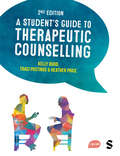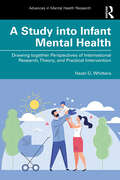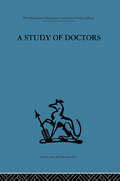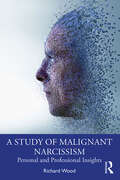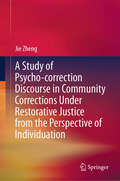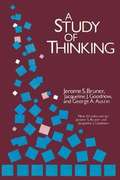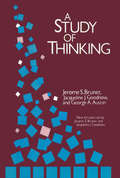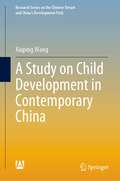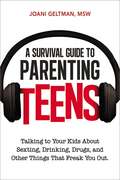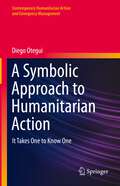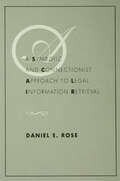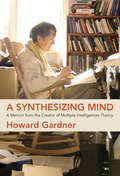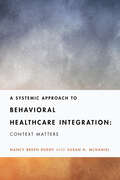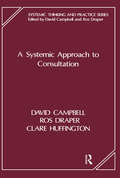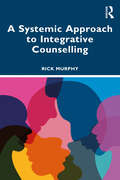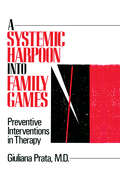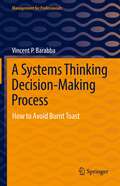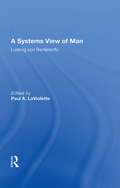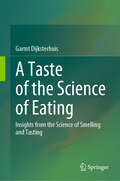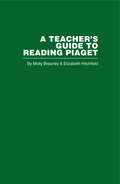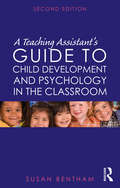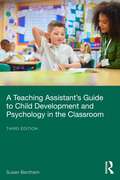- Table View
- List View
A Student′s Guide to Therapeutic Counselling
by Traci Postings Heather Price Kelly BuddThis highly practical book, published in partnership with CPCAB, is a comprehensive training guide for learners on diploma practitioner courses at Level 4 and above. Based around CPCAB’s seven core processes of practitioner development, it introduces core curriculum topics including knowledge, skills and practice issues. It provides learners with essential support through study tips and answers to their most commonly asked questions.
A Student′s Guide to Therapeutic Counselling
by Traci Postings Heather Price Kelly BuddThis highly practical book, published in partnership with CPCAB, is a comprehensive training guide for learners on diploma practitioner courses at Level 4 and above. Based around CPCAB’s seven core processes of practitioner development, it introduces core curriculum topics including knowledge, skills and practice issues. It provides learners with essential support through study tips and answers to their most commonly asked questions.
A Study into Infant Mental Health: Drawing together Perspectives of International Research, Theory, and Practical Intervention (Advances in Mental Health Research)
by Hazel G. WhittersThis book is a study of infant mental health which blends knowledge and understanding from three perspectives: international research, theory, and intervention. The volume increases awareness of the significance of infant mental health, adding to the growing body of literature on influences upon lifestyles, communities, society, and attainment. The significance of mental health to development has come to the fore in recent years and research in neuroscience is used to explore, and to understand the complexities of the human brain. Each infant is exposed to unique influences before and after birth. Neuroscience, genetics, adverse childhood experiences, and personalities feature in the chapters as mitigating factors to attainment. Exemplars create a bridge between research and implementation of recommendations, and illustrate the myriad of influences and permutations that can enhance or hinder development. This book discusses internal influences from an infant’s biological make-up, alongside the circumstances and relationships within a family unit, as understanding these key aspects is integral to promotion of each infant’s life chances. The volume concludes by considering future approaches to nurturing infant mental health. Carefully designed to stimulate discussion and professional inquiry, this volume is an invaluable resource for researchers, academics, and scholars with an interest in infant mental health.
A Study of Doctors: Mutual selection and the evaluation of results in a training programme for family doctors
by Michael Balint Enid Balint Robert Gosling Peter HilderbrandTavistock Press was established as a co-operative venture between the Tavistock Institute and Routledge & Kegan Paul (RKP) in the 1950s to produce a series of major contributions across the social sciences. This volume is part of a 2001 reissue of a selection of those important works which have since gone out of print, or are difficult to locate. Published by Routledge, 112 volumes in total are being brought together under the name The International Behavioural and Social Sciences Library: Classics from the Tavistock Press. Reproduced here in facsimile, this volume was originally published in 1966 and is available individually. The collection is also available in a number of themed mini-sets of between 5 and 13 volumes, or as a complete collection.
A Study of IMAGINATION IN EARLY CHILDHOOD: and its Function in Mental Development (International Library Of Psychology Ser. #Vol. 9)
by Griffiths, RuthFirst published in 1999. Routledge is an imprint of Taylor & Francis, an informa company.
A Study of Malignant Narcissism: Personal and Professional Insights
by Richard WoodA Study of Malignant Narcissism offers a unique insight into malignant narcissism, exploring both its personal and professional aspects and constructing a theoretical framework that renders its origins and manifestations more accessible. With reference to his own family dynamic and to 45 years of professional experience, Richard Wood explores the psychology of malignant narcissism, positing it as a defence against love. The book first offers an overview of existing literature before examining relevant clinical material, including an analysis of Wood’s relationships with his own parents. Wood presents vignettes illustrating the core dynamics that drive narcissism, illustrated with sections of his father’s unpublished autobiography and with his patient work. The book makes the case for malignant narcissism to be considered a subtype of psychopathy and puts forth a framework setting out the key dynamics that typify these individuals, including consideration of the ways in which malignant narcissism replicates itself in varied forms. Finally, Wood examines the impact of narcissistic leadership and compares his theoretical position with those of other clinicians. This book will be of interest to clinical psychologists, psychoanalysts, and psychotherapists, as well as all professionals working with narcissistic patients.
A Study of Psycho-correction Discourse in Community Corrections Under Restorative Justice from the Perspective of Individuation
by Jie ZhengThis book enriches the theory of individuation within Systemic Functional Linguistics, providing an interdisciplinary theoretical model for the study of individuation, which represents a direct contribution to the study of the theory of individuation. It explains how the counselors in community corrections use social semiotic resources to educate the offenders and correct their deviant psychologies and behaviors, and how the offenders use social semiotic resources to achieve their own transformation and reintegration, demonstrating the appliability and social explanatory orientation of the theory of individuation. The book subsequently demonstrates the inherent relationship between the concept of restorative justice and the discourse practice of psycho-correction in community corrections, expanding the research scope of Systemic Functional Linguistics and Legal Linguistics in the process. It also provides a reference guide for improving the practice of psycho-correction in community corrections and can be used for language training of the counselors.
A Study of Thinking
by Jerome S. Bruner Jacqueline J. Goodnow George Austin Roger W. Brown<p>A Study of Thinking is a pioneering account of how human beings achieve a measure of rationality in spite of the constraints imposed by bias, limited attention and memory, and the risks of error imposed by pressures of time and ignorance. First published in 1956 and hailed at its appearance as a groundbreaking study, it is still read three decades later as a major contribution to our understanding of the mind. In their insightful new introduction, the authors relate the book to the cognitive revolution and its handmaiden, artificial intelligence. <p>The central theme of the work is that the scientific study of human thinking must concentrate upon meaning and its achievement rather than upon the behaviorists' stimuli and responses and the presumed connections between them. The book's point of departure is how human beings group the world of particulars into ordered classes and categories—concepts—in order to impose a coherent and manageable order upon that world. But rather than relying principally on philosophical speculation to make its point, A Study of Thinking reports dozens of experiments to elucidate the strategies that people use in penetrating to the deep structure of the information they encounter.</p>
A Study of Thinking
by Jerome BrunerA Study of Thinking is a pioneering account of how human beings achieve a measure of rationality in spite of the constraints imposed by bias, limited attention and memory, and the risks of error imposed by pressures of time and ignorance. First published in 1956 and hailed at its appearance as a groundbreaking study, it is still read three decades later as a major contribution to our understanding of the mind. In their insightful new introduction, the authors relate the book to the cognitive revolution and its handmaiden, artificial intelligence.The central theme of the work is that the scientific study of human thinking must concentrate upon meaning and its achievement rather than upon the behaviorists' stimuli and responses and the presumed connections between them. The book's point of departure is how human beings group the world of particulars into ordered classes and categories-concepts-in order to impose a coherent and manageable order upon that world. But rather than relying principally on philosophical speculation to make its point, A Study of Thinking reports dozens of experiments to elucidate the strategies that people use in penetrating to the deep structure of the information they encounter.This seminal study was a major event in the cognitive revolution of the 1950s. Reviewing it at the time, J. Robert Oppenheimer said it "has in many ways the flavor of conviction which makes it point to the future."
A Study on Child Development in Contemporary China (Research Series on the Chinese Dream and China’s Development Path)
by Xiuping WangThis book is devoted to the description and analysis of child population, rights to survival and development, culture and policies that Chinese government made in contemporary China. The book pursues three major objectives: firstly, to objectively describe child development in contemporary China ; secondly, to analyze characteristics of child development in contemporary China; and thirdly, to review all types of policies Chinese government has made on children survival, protection and development, which played important roles on promoting child development.
A Survival Guide to Parenting Teens: Talking to Your Kids About Sexting, Drinking, Drugs, adn Other Things That Freak You Out
by Joani GeltmanThe teenage years will bring problems that will make any parent long for the days of their childhood. However, you&’re not alone! This invaluable resource tackles all of the issues that you can possibly encounter with your teen.Oh to be able to return to the days of messy bedrooms and preteen attitudes! Now as parents of teenagers, the days have the potential of bringing us not-so-fun issues like sexting, cyber-bullying, and eating disorders. Let&’s not forget the old standbys of drugs, alcohol, and depression. As much as you pray that your child will be the shining exception, as their parent you must still be prepared!Will you know what to do when a naked picture of your daughter gets forwarded by her &“boyfriend&” to the entire school? How will you respond when your child is bullied online--or is the bully himself?A Survival Guide to Parenting Teens has thought through all the issues you haven&’t, covering a broad range of issues including:sex,drinking,drugs,depression,defiance,laziness,conformity,entitlement, and moreParenting expert Joani Geltman approaches 80 uncomfortable topics with honesty and a dash of humor. She reveals what your teens are thinking and feeling--and what developmental factors are involved. A Survival Guide to Parenting Teens explains how to approach each problem in a way that lets your kid know you &“get it&” and leads to truly productive conversations.
A Symbolic Approach to Humanitarian Action: It Takes One to Know One (Contemporary Humanitarian Action and Emergency Management)
by Diego OteguiThis book aims to present an alternative view of humanitarian action. It adds to current conversations and dilemmas within the humanitarian sphere by departing from traditional views that consider humanitarian interventions as a concrete human activity aimed at providing relief to disaster victims. Much differently, it invokes the idea that humanitarian action is also a cognitive process. In this process, both humanitarians and disaster survivors alike, unknowingly, apply historically, societally, and culturally defined symbolic constructions to make sense of post-disaster information and to make decisions. In the specific case of humanitarian workers, these symbolic constructions influence how they understand their post-disaster reality, including how they relate to those they consider to be in pain or distress. This way of looking at humanitarian action builds upon a robust theoretical framework called Institutional Logics, which helps us identify and interpret how individuals make sense of their reality. So it brings the complex world of the individual into a discussion that generally considers the organization as the unit of analysis. Studying humanitarian action through this alternative lens makes it easy to see that objective and verifiable post-disaster information is a necessary but not a sufficient condition to design humanitarian interventions, let alone assess their value and benefits. A Symbolic Approach to Humanitarian Action: It Takes One to Know One aims to bridge the gap between research and practice in humanitarian action by translating academic knowledge into an accessible format that can be used by practitioners to improve their work on the ground.
A Symbolic and Connectionist Approach To Legal Information Retrieval
by Daniel E. RoseMany existing information retrieval (IR) systems are surprisingly ineffective at finding documents relevant to particular topics. Traditional systems are extremely brittle, failing to retrieve relevant documents unless the user's exact search string is found. They support only the most primitive trial-and-error interaction with their users and are also static. Even systems with so-called "relevance feedback" are incapable of learning from experience with users. SCALIR (a Symbolic and Connectionist Approach to Legal Information Retrieval) -- a system for assisting research on copyright law -- has been designed to address these problems. By using a hybrid of symbolic and connectionist artificial intelligence techniques, SCALIR develops a conceptual representation of document relationships without explicit knowledge engineering. SCALIR's direct manipulation interface encourages users to browse through the space of documents. It then uses these browsing patterns to improve its performance by modifying its representation, resulting in a communal repository of expertise for all of its users. SCALIR's representational scheme also mirrors the hybrid nature of the Anglo-American legal system. While certain legal concepts are precise and rule-like, others -- which legal scholars call "open-textured" -- are subject to interpretation. The meaning of legal text is established through the parallel and distributed precedence-based judicial appeal system. SCALIR represents documents and terms as nodes in a network, capturing the duality of the legal system by using symbolic (semantic network) and connectionist links. The former correspond to a priori knowledge such as the fact that one case overturned another on appeal. The latter correspond to statistical inferences such as the relevance of a term describing a case. SCALIR's text corpus includes all federal cases on copyright law. The hybrid representation also suggests a way to resolve the apparent incompatibility between the two prominent paradigms in artificial intelligence, the "classical" symbol-manipulation approach and the neurally-inspired connectionist approach. Part of the book focuses on a characterization of the two paradigms and an investigation of when and how -- as in the legal research domain -- they can be effectively combined.
A Synthesizing Mind: A Memoir from the Creator of Multiple Intelligences Theory
by Howard GardnerThe influential author and eminent authority on the human mind reflects on his groundbreaking work and the many forms of intelligence--including his own.Howard Gardner's Frames of Mind was that rare publishing phenomenon--a mind-changer. Widely read by the general public as well as by educators, this influential book laid out Gardner's theory of multiple intelligences. It debunked the primacy of the IQ test and inspired new approaches to education; entire curricula, schools, museums, and parents' guides were dedicated to the nurturing of the several intelligences. In his new book, A Synthesizing Mind, Gardner reflects on his intellectual development and his groundbreaking work, tracing his evolution from bookish child to eager college student to disengaged graduate student to Harvard professor.
A Systemic Approach to Behavioral Healthcare Integration: Context Matters (Fundamentals of Clinical Practice With Couples and Families Series)
by Dr. Nancy Breen Ruddy PhD Dr. Susan H. McDanielThis book provides clinicians, consultants, and healthcare administrators with a roadmap to establishing a systemic, patient-centered, family-oriented behavioral health service that is integrated into a healthcare setting. Healthcare that goes beyond biomedical issues to address our whole biopsychosocial selves, produces better outcomes for patients and families. Integrating behavioral health into medical settings requires an understanding of the interplay of multiple systemic layers in American healthcare. The existing literature on integration largely fails to address the "big picture" of integrated services and systems, including operations, clinical processes, and financial sustainability elements.A Systemic Approach to Behavioral Healthcare Integration summarizes the literature on the impact of integrating behavioral health care into medical settings, on the role of families in health maintenance and chronic disease management, and on team science and applying family systems theory/relational science to the teams that are now essential to healthcare.
A Systemic Approach to Consultation (The Systemic Thinking and Practice Series)
by David Campbell Ros Draper Clare HuffingtonA Systemic Approach to Consultation discusses the application of systemic thinking to work within organizations. The authors draw on their experiences of consulting with teams, departments and whole organizations in both the public and private sectors. They describe their work as an integrated approach called Development Consultation, which focuses on the beliefs and behaviors in the wider system which makes it difficult for organizations to manage their own processes of change. The authors then discuss the way they formulate systemic problems and the interventions, particularly the interviewing technique, which they have used in numerous case examples. The book is intended as a handbook for professionals from any discipline who are engaged in consultation work.
A Systemic Approach to Integrative Counselling
by Rick MurphyThis book presents systemic psychotherapy to integrative counsellors by using the most common counselling modalities and turning them into systemic approaches.|A Systemic Approach to Integrative Counselling teaches systemic theory and techniques gradually, delving into various ways for integrative counsellors to think from a systemic perspective, reframing a client’s presenting problem as emerging from relationships and social context. The chapters discuss how to combine person-centred counselling with a systemic outlook, how to combine psychodynamic theory with ideas about circularity and relationships, and outlines ways to use cognitive-behavioural therapy, action techniques, drama techniques, gestalt therapy, and many counselling approaches systemically with individual clients. The author’s conversational writing, accompanied with case studies and in-depth explanations of counselling techniques and theories, makes the material interactive and accessible.A Systemic Approach to Integrative Counselling will provide qualified and trainee counsellors with an in-depth systemic outlook on counselling modalities. It is also a helpful guide for scholars and researchers in related fields.
A Systemic Harpoon Into Family Games: Preventive Interventions in Therapy
by Giuliana PrataPublished in 1990, A Systematic Harpoon Into Family Games is a valuable contribution to the field of Family Therapy, using games that were utilised in a workshop in Finland, August 1986, organized by the Family Therapists' Association and the Association for Mental Health. This book was written for professionals who every day, within either the public or the private sector, meet families, couples, or individual patients. The author’s main concern was to supply less experienced colleagues with a working tool which could help them on a clinical level.
A Systems Thinking Decision-Making Process: How to Avoid Burnt Toast (Management for Professionals)
by Vincent P. BarabbaThis book illustrates how to access the right information for making the best decisions during turbulent times. It is written from an experienced-based perspective that is beneficial for those looking for the development and improvement of the decision-making process. The approach is centered on the author’s experience in developing and implementing effective and efficient approaches to decision-making in business and government. Based on those experiences, this book provides insights into how to improve the decision making process of your organization, whether it be large or small. For decision makers and those providing market information for making decisions, this book provide guidelines for a framework which includes systems thinking. For those interested in change management and corporate governance, the book presents examples where it was done well and some examples where it was not and the ensuring consequences. Praise for Systems Thinking Decision-Making Process… "This is an absolutely incredible book by a distinguished practitioner. The range of knowledge and experience that Vince Barabba has had is astounding. I urge everyone who is interested in complex, messy problems to read this amazing book.” --Ian I. Mitroff “…Vince has masterfully blended the art of organizational respect with the science of data inquiry to drive change and realize strategic vision. A master storyteller, he does not just teach, his book brings his learnings to life in a meaningful way that if carefully listened to, can change the course of a career.” -- Paul D'Alessandro Principal, Health Industries, PwC US “In his latest book, Vince Barabba integrates his vast knowledge from 50 years of dedicated work in both the public and private sectors in order to provide leaders with an actionable framework for radically improving how their organizations collect and use information to make the best decisions for all the wicked messes that now appear in our global village… This book can save your company from living in the dark with false assumptions about all your key stakeholders.” -- Ralph H. Kilmann, Ph.D. CEO, Kilmann Diagnostics Co-Author, The Thomas-Kilmann Conflict Mode Instrument (TKI) "Absorbing just a few of the many smart ideas in this book will make you a better leader and decision maker. Thinking systemically about how the hard-earned lessons from Vince Barabba’s brilliant career apply to your enterprise could make you a great one." — Chunka Mui Co-Author, A Brief History of a Perfect Future and Billion Dollar Lessons “…if you are interested in ‘thinking in systems,’ this book is for you. The ‘On Star’ story demonstrates to you how the initial product-centered thinking was proselytized to ‘thinking in systems’." -- John Pourdehnad Visiting Professor, IESE Business School and Faulty of Systems Leadership, Thomas Jefferson University “In writing Systems Thinking Decision-Making Process: How to Avoid Burnt Toast, Vince Barabba is addressing the limits of knowledge management systems which enable ‘organizations as usual’ to share best practices on how to scrape toast faster and cheaper… The examples shared by Vince, from his first-hand experiences in corporate America or his services as a marketing consultant, contribute invaluable clarity to his goal of providing a “sketch of an Inquiry Center Learning and Support System” for those with the ambition to lead efforts to work smarter, not harder, firmly against the grain of ‘organizations as usual’…” -- Bill Bellows, Ph.D., President, InThinking Services Adjunct Professor, California State University, Northridge and Southern Utah University Advisory Council Member and Former Deputy Director, The W. Edwards Deming Institute® “In his ‘last book’, Vince weaves the experiences and learning of a lifetime into whole cloth of insight
A Systems View Of Man: Collected Essays
by Ludwig von BertalanffyWhat does it mean to be human? What distinguishes man from other animals? “Man’s creation of the universe of symbols,†replies Ludwig von Bertalanffy. “Man lives in a world not of things, but of symbols.†Dr. von Bertalanffy explores the historical development of symbolic language, examines the nature of human values, and shows how a current breakdown of symbolic universes contributes to the feeling of meaninglessness so prevalent in modern society. He notes that a major portion of mankind’s aggressive acts are not biologically induced but arise within symbolic frameworks.
A Taste of the Science of Eating: Insights from the Science of Smelling and Tasting
by Garmt DijksterhuisWhy do you taste what you taste, and what about smelling? Many books address good food, but few go deeper, explaining the processes behind smelling and tasting. The book addresses the senses of smell and taste and the many more senses and their interactions during eating. It also stresses the importance of psychology when you smell, taste and eat. Some of the other topics include flavour, the working of the nose and olfactory (cross-)adaptation, the use of odorants, the relation between emotion and eating, and many more. The book helps you understand why you like and eat food, and shows the intriguing complexity of the area.
A Taxonomy of Visual Processes (The Uttal Tetralogy of Cognitive Neuroscience)
by William R. UttalOriginally published in 1981, this third volume deals with the empirical data base and the theories concerning visual perception – the set of mental responses to photic stimulation of the eyes. As the book develops, the plan was to present a general taxonomy of visual processes and phenomena. It was hoped that such a general perspective would help to bring some order to the extensive, but largely unorganized, research literature dealing with our immediate perceptual responses to visual stimuli at the time. The specific goal of this work was to provide a classification system that integrates and systematizes the data base of perceptual psychology into a comprehensive intellectual scheme by means of an eclectic, multi-level metatheory invoking several different kinds of explanation.
A Teacher's Guide to Reading Piaget
by M. Brearley E. HitchfieldThis book was first published in 1966.
A Teaching Assistant's Guide to Child Development and Psychology in the Classroom: Second edition
by Susan BenthamHow can you help students most effectively in the classroom? As a Teaching Assistant, you play a vital role in today’s schools. This fully updated new edition will help you get to grips with the main issues to do with psychology and its role in the processes of teaching and learning. This accessible text, building on the success of a best-selling previous edition, provides informative, yet down-to-earth commentary with clear examples of how you can apply this knowledge in everyday practice. The book addresses issues including: how to support learning how to identify and cater for different learning styles teaching children with additional needs how to manage behaviour to support learning how to help children with their self-esteem and independence. This new edition includes references to up-to-date research in child development and psychology to include information regarding personalised learning, creativity, motivation, friendships skills, moral development and neuroscience. Chapters are complemented with lively case studies, self-assessment questions and examples of how to apply theory to everyday classroom practice. The reader is encouraged to develop reflective practice to best support childrens’ behaviour and learning. This reader-friendly book is an invaluable companion for every Teaching assistant, HLTA, Cover Supervisor, and anyone working in a supporting role in an educational setting.
A Teaching Assistant’s Guide to Child Development and Psychology in the Classroom
by Susan BenthamHow can you help students most effectively in the classroom? As a teaching assistant, you play a vital role in today’s schools. This fully updated third edition will help you get to grips with the main issues to do with psychology and its role in the processes of teaching and learning.This accessible text provides informative, yet down-to-earth commentary with clear examples of how you can apply this knowledge in everyday practice. This book addresses issues such as how to support learning and behaviour, how to create an optimal learning environment for all students, ways to encourage pupil voice, supportive strategies for children with additional needs, and how to help children with their self-esteem and independence. This new edition includes references to up-to-date research in child development and psychology to include information regarding wellbeing, mental health, and learning strategies related to insights from cognitive science. Chapters are complemented with lively case studies, self-assessment questions, and examples of how to apply theory to everyday classroom practice. The reader is encouraged to develop reflective practice to best support children’s behaviour and learning.This reader-friendly book is an invaluable companion for every teaching assistant, HLTA, pastoral support assistant, learning mentor, classroom cover supervisor and anyone working in a supporting role in an educational setting.
